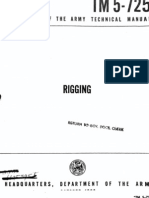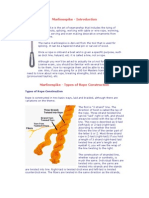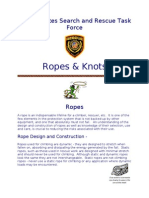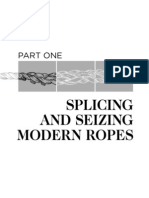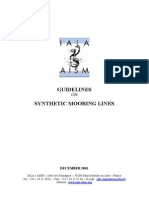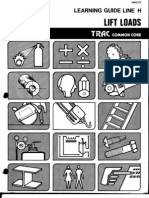Ropes and Wires
Ropes and Wires
Uploaded by
bernardinodinoCopyright:
Available Formats
Ropes and Wires
Ropes and Wires
Uploaded by
bernardinodinoOriginal Title
Copyright
Available Formats
Share this document
Did you find this document useful?
Is this content inappropriate?
Copyright:
Available Formats
Ropes and Wires
Ropes and Wires
Uploaded by
bernardinodinoCopyright:
Available Formats
8.
Ropes and Wires
Regardless of the type of ship you are serving on, ropes and wires are part of your daily existence and, if outside the engine room, they are your responsibility. Using the correct cordage in the proper way and the inspection of this is essential. Too many lives at sea are lost by the abuse of wires and ropes and the failure to inspect and replace defective items. Most heavy work ropes at sea are Manila, sisal, nylon or polypropylene, and the chart below provides a comparison.
"Ratings: Best -1, Poorest - 5
8.1 Manila Rope
The main problem with Manila rope is that it has to be stored dry, which causes difficulties if it is used as mooring rope and has to be stowed below in a wet condition. If this occurs the line should
50
be flaked down, if possible, to give it the best chance of drying out. Other problems are that it is heavy, particularly when wet, and does not float, requiring more manpower in handling. Deterioration of the rope is indicated by a discolouration from yellowish white to grey, although to distinguish this from surface grime the inner part of the rope has to be inspected. A further indication of deterioration is bristling ends of broken yarn, and rope that is overstrained will show a decrease in diameter. Natural rope when overstrained will give out cracking noises and wet rope can show a steamlike vapour. All of these signs indicate a line that is in danger of breaking. In normal usage natural fibre rope deteriorates by around 30% in two years.
8.2 Sisal Rope
This is again a natural fibre rope, considerably cheaper than Manila and therefore niton used instead of it. It has about 80% of the strength of Manila and lasts about the same time, although it is easily damaged by continuous exposure to weather.
8.3
Nylon Rope
Of the synthetic ropes, nylon is the best. It is more expensive than Manila but lasts longer and, on an equal diameter, is 3 times stronger, It is impervious to weather and can be stowed away when wet as it does not absorb water. II is particularly good for mooring lines and any other use where limited shock is required as it stretches up to 30% of its length under normal working loads without any degradation of the line. Similar to Manila rope, nylon rope when under strain emits cracking noises and can also show the same steam-like vapour when wet. Synthetic rope should always have more turns put on bits than natural fibre rope as the friction ratio Is less. While all rope under strain should be kept well clear of, nylon rope in particular must be treated very carefully because of the severe backlash on breaking, with the rope possibly stretched to up to 50% of its length at this point.
8.4
Polypropylene Rope
This is cheaper than nylon rope, does not stretch as well and so produces more shock. It is not as strong but it does have some advantages in that it floats and is lighter than a nylon rope of equal diameter, so is easier to handle. It is more susceptible to damage from sunlight though and should be kept covered when stowed outside.
8.5 Wire Ropes
Wire rope consists of a number of strands laid helically around a supporting core. Individual strands are composed of a number of wires laid helically around a centre (core) of wire or fibre. The lay of a wire rope is defined by the direction in which the strands are laid into the rope, and by the direction in which the wires are laid into the strands.
8.6 Wire Rope Cores
At the centre of every wire rope is a core, usually made from either wire or fibre. The core acts as foundation for the strands, keeps the rope round and provides clearance between the rope strands for unrestricted movement. Ropes with fibre cores have greater elasticity, but metallic cores afford greater strength and resistance to crushing. The following different kinds of wire rope cores are available: Independent Wire Rope Core (IWRC), wire strand, Manila fibre, sisal fibre or polypropylene. Under normal operating conditions, a fibre core provides fully adequate support for the strands and acts as a reservoir for the lubricant. Wire cores are usually composed of a separate 7 x 7 wire rope, termed Independent Wire Rope Core (IWRC). In any case where heavy loads or over-winding on a drum will cause excessive pressure of strands against the core, the IWRC is a necessity.
52
8.8 Handling Upon receiving a shipment of wire rope, close attention to the packaging is the first important measure in proper and appropriate care. If, for example, the reel has broken or split flanges or loose inner sleeves, it is a fair assumption that there could be damage to the rope as well. Always check for distortions in the outer wraps of the reel or any conditions resulting from forklift abuse.
8.9 Care and Inspection
Wire rope is subject to the same wear and tear of all metals at sea. If the diameter of the wire is decreased it is an indication that the wire has been under strain for a prolonged time. A good indication of deterioration of wire rope is broken wire strands standing proud of the wire. These are commonly called fishhooks as they can rip open an unwary hand or, if wearing gloves, can catch on the glove and drag the wearer's hand into a block or drum. To prevent corrosion and rust the wire must be lubricated regularly. Some wires are galvanised to prevent rusting, but in this process the strength of the wire deteriorates by up to 10%.
53
You might also like
- Wire Rope LubricationDocument16 pagesWire Rope LubricationAnonymous alQXB11EgQNo ratings yet
- Mining Machinery Nit RourkelaDocument343 pagesMining Machinery Nit RourkelaNaren Gujjar100% (8)
- 1 - Ropes PDFDocument12 pages1 - Ropes PDFClarence Pietersz0% (1)
- TM 5 725 RiggingDocument147 pagesTM 5 725 RiggingDragon04100% (1)
- Ochure ulstEINDocument4 pagesOchure ulstEINbernardinodino100% (1)
- Manoeuvring BookletDocument29 pagesManoeuvring Bookletbernardinodino100% (4)
- RopesDocument25 pagesRopessabeerNo ratings yet
- Week-4 PPTDocument29 pagesWeek-4 PPTDilbert BatingaNo ratings yet
- Nautical Knoweldge - 1 - Cable-Rope Wire & ChainDocument30 pagesNautical Knoweldge - 1 - Cable-Rope Wire & ChainKostyantinBondarenkoNo ratings yet
- Marlinespike - Introduction: Types of Rope ConstructionDocument23 pagesMarlinespike - Introduction: Types of Rope Constructiondavidantis100% (1)
- 02 Wire Rope StrandDocument39 pages02 Wire Rope Strandmanuelperezz2567% (3)
- Ropes and WiresDocument13 pagesRopes and WiresPrinceNo ratings yet
- Pe ReviewerDocument9 pagesPe ReviewerprincessmaecanoogNo ratings yet
- Ropes and KnotsDocument17 pagesRopes and KnotsraxXEBEDENo ratings yet
- Rope and WiresDocument22 pagesRope and WiresMiki CsereNo ratings yet
- Rigging KNOTSDocument13 pagesRigging KNOTSDexter Fernandez100% (1)
- Rope WorkDocument5 pagesRope WorkcommandoNo ratings yet
- Fiber Rope and Wire RopeDocument20 pagesFiber Rope and Wire RopeGabrielNo ratings yet
- Rigging and HoistingDocument106 pagesRigging and HoistingLijo JohnNo ratings yet
- Types of RopesDocument45 pagesTypes of RopesRoi Dominic A. Baygar100% (1)
- Notes On Ropes & Wires SOT I 2012 Unit 4Document21 pagesNotes On Ropes & Wires SOT I 2012 Unit 4James MonishNo ratings yet
- Unit 3. BS SWL Chain Register Incl Wire Rope exam-SENT ONDocument11 pagesUnit 3. BS SWL Chain Register Incl Wire Rope exam-SENT ONDankNo ratings yet
- Crane and Lifting SafetyDocument41 pagesCrane and Lifting SafetySarferi AbdullahNo ratings yet
- Rope Work #1: by James L. Matews Master, H.B.M.S. RichmondDocument5 pagesRope Work #1: by James L. Matews Master, H.B.M.S. RichmondbackpacktwcNo ratings yet
- Care Maint. StrengthDocument8 pagesCare Maint. StrengthMitanshu ChadhaNo ratings yet
- Ropes, Lines and Knots (Marlinespike Seamanship) : Rope Construction MaterialsDocument6 pagesRopes, Lines and Knots (Marlinespike Seamanship) : Rope Construction MaterialsHenry SngNo ratings yet
- Wire Rope DefectsDocument5 pagesWire Rope DefectsAnonymous ntE0hG2TP100% (1)
- Types of Synthetic RopeDocument4 pagesTypes of Synthetic RopeMitanshu ChadhaNo ratings yet
- The Splicing Handbook Chapter 1Document17 pagesThe Splicing Handbook Chapter 1Archie AdkinsNo ratings yet
- important points on wires and ropes - копияDocument2 pagesimportant points on wires and ropes - копияВлад РайлиNo ratings yet
- Technical Manual Rev 121021Document20 pagesTechnical Manual Rev 121021José Alberto Garcia CordovaNo ratings yet
- MarlinspikeDocument30 pagesMarlinspikeMitchell WillieNo ratings yet
- Mechanical Lifting SafetyDocument19 pagesMechanical Lifting SafetyHse GroupNo ratings yet
- Tug Tow Rope Systems and Planned Maintenance Procedures: Robert Underhill, Jeyco Mooring and Rigging Equipment, AustraliaDocument6 pagesTug Tow Rope Systems and Planned Maintenance Procedures: Robert Underhill, Jeyco Mooring and Rigging Equipment, AustraliaDeanna BarrettNo ratings yet
- Wire Rope General InformationDocument16 pagesWire Rope General Informationwindgust82No ratings yet
- Inspection of WiresDocument12 pagesInspection of Wiresdenis_john_2No ratings yet
- Canada Cordage Inc-RopeDocument7 pagesCanada Cordage Inc-RopeTagor SianiparNo ratings yet
- Inspection and MaintenanceDocument1 pageInspection and Maintenancejieunibanez507No ratings yet
- 2.2 Wire RopesDocument20 pages2.2 Wire Ropesrfelippe8733No ratings yet
- SEAMANSHIP (1 and 2)Document11 pagesSEAMANSHIP (1 and 2)Maria Kris Joaquin Capati100% (1)
- Telescopic ChuteDocument80 pagesTelescopic ChuteINFINITI100% (1)
- Wire Ropes SSCDocument16 pagesWire Ropes SSCIbrahim KaziNo ratings yet
- The Morrow Guide To KnotsDocument253 pagesThe Morrow Guide To KnotsMaya Daya100% (3)
- Wire RopeDocument9 pagesWire RopeMitanshu ChadhaNo ratings yet
- Military MountaineeringDocument21 pagesMilitary MountaineeringSean Ben Kadusale100% (1)
- Use and Care of Wire RopeDocument8 pagesUse and Care of Wire RopeAnonymous 7fsk6ZFMNo ratings yet
- Guidel 26Document25 pagesGuidel 26Ashley PerrettNo ratings yet
- General Information: Wire Rope SlingsDocument7 pagesGeneral Information: Wire Rope Slingsegy pureNo ratings yet
- Knots You Need to Know: Easy-to-Follow Guide to the 30 Most Useful KnotsFrom EverandKnots You Need to Know: Easy-to-Follow Guide to the 30 Most Useful KnotsNo ratings yet
- Lift Loads TRAC Line HDocument149 pagesLift Loads TRAC Line HRadu DraganNo ratings yet
- Net Making Made Simple - A Guide to Making Nets for Sport and HomeFrom EverandNet Making Made Simple - A Guide to Making Nets for Sport and HomeNo ratings yet
- Wire RopesDocument28 pagesWire RopesHemant KngNo ratings yet
- Wire Rope ConstructionDocument3 pagesWire Rope ConstructionLutfi Ismail100% (1)
- J R McCalmont - Rope On The Farm 1964 PDFDocument18 pagesJ R McCalmont - Rope On The Farm 1964 PDFJoan LeavyNo ratings yet
- WireDocument51 pagesWireMadhav Rajpurohit100% (1)
- Seman 5Document10 pagesSeman 5Foad AlwansonNo ratings yet
- Accidents During Mooring OperationsDocument7 pagesAccidents During Mooring OperationsCristel_DCNo ratings yet
- Group8 - Synthetic and Natural Fiber LinesDocument3 pagesGroup8 - Synthetic and Natural Fiber LinesaaronjerseyrosalNo ratings yet
- RopesDocument1 pageRopesAlina BarbuNo ratings yet
- A Guide to the Use of Climbing Rope - A Collection of Historical Mountaineering Articles on Rope TechniqueFrom EverandA Guide to the Use of Climbing Rope - A Collection of Historical Mountaineering Articles on Rope TechniqueNo ratings yet
- Us Navy Selects Ion Track S Vaportracer To Fight Terrorism, Improve Force ProtectionDocument2 pagesUs Navy Selects Ion Track S Vaportracer To Fight Terrorism, Improve Force ProtectionbernardinodinoNo ratings yet
- Equipos Automaticos de Deteccion de ExplosivosDocument12 pagesEquipos Automaticos de Deteccion de ExplosivosbernardinodinoNo ratings yet
- Explosives-Detection Systems: Configuration Management and Performance Verification ofDocument20 pagesExplosives-Detection Systems: Configuration Management and Performance Verification ofbernardinodinoNo ratings yet
- Republic of The Marshall Islands Office of The Maritime AdministratorDocument5 pagesRepublic of The Marshall Islands Office of The Maritime AdministratorbernardinodinoNo ratings yet
- Explosives Sampling SystemDocument2 pagesExplosives Sampling SystembernardinodinoNo ratings yet
- Ship's Ballast ConventionDocument5 pagesShip's Ballast ConventionbernardinodinoNo ratings yet
- Advisory: What Should You Do?Document1 pageAdvisory: What Should You Do?bernardinodinoNo ratings yet
- 2000 - NIJ - A Guide For Explosion and Bombing Scene InvestigationDocument64 pages2000 - NIJ - A Guide For Explosion and Bombing Scene Investigationfaradio2100% (2)
- Equipos Automaticos de Deteccion de ExplosivosDocument12 pagesEquipos Automaticos de Deteccion de ExplosivosbernardinodinoNo ratings yet
- ISPS Clause For Voyage Charter PartiesDocument3 pagesISPS Clause For Voyage Charter PartiesbernardinodinoNo ratings yet
- LNGDocument2 pagesLNGbernardinodinoNo ratings yet
- 112 LNG Propulsion GuideDocument74 pages112 LNG Propulsion Guidebernardinodino100% (2)
- SIGTTO BookletDocument6 pagesSIGTTO BookletbernardinodinoNo ratings yet
- World S First Large Size: LNG Carrier With Electric PropulsionDocument2 pagesWorld S First Large Size: LNG Carrier With Electric PropulsionbernardinodinoNo ratings yet
- ECDIS Certifcate For OfficersDocument2 pagesECDIS Certifcate For OfficersbernardinodinoNo ratings yet
- Gastech: Kazuaki YuasaDocument16 pagesGastech: Kazuaki YuasabernardinodinoNo ratings yet
- Propulsion Systems For Future LNG CarriersDocument4 pagesPropulsion Systems For Future LNG CarriersbernardinodinoNo ratings yet
- Freefall Lifeboats: in Maritime EquipmentDocument4 pagesFreefall Lifeboats: in Maritime Equipmentbernardinodino100% (1)
- Facts FellowSHIP and Viking Lady2Document2 pagesFacts FellowSHIP and Viking Lady2bernardinodinoNo ratings yet
- Good Practice: Enclosed Lifeboat LaunchingDocument20 pagesGood Practice: Enclosed Lifeboat Launchingbernardinodino0% (1)
- Post OPA-90 Vessel Oil Transfer Spill Prevention: The Effectiveness of Coast Guard EnforcementDocument22 pagesPost OPA-90 Vessel Oil Transfer Spill Prevention: The Effectiveness of Coast Guard EnforcementbernardinodinoNo ratings yet
- Maritimenewzealand Accidente RenaDocument20 pagesMaritimenewzealand Accidente RenabernardinodinoNo ratings yet
- Worksheet23 MaritimeDocument2 pagesWorksheet23 MaritimebernardinodinoNo ratings yet



